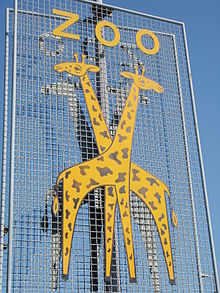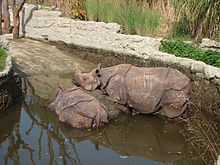
The San Diego Zoo Safari Park, originally named the San Diego Wild Animal Park until 2010, is an 1,800 acre zoo in the San Pasqual Valley area of San Diego, California, near Escondido. It is one of the largest tourist attractions in San Diego County. The park houses a large array of wild and endangered animals including species from the continents of Africa, Asia, Europe, North and South America, and Australia. This includes the largest collection of hoofed mammals in the world. The park is in a semi-arid environment, and one of its most notable features is the Africa Tram, which explores the expansive African exhibits. These free-range enclosures house such animals as antelopes, giraffes, buffalo, cranes, and rhinoceros. The park is also noted for its California condor breeding program.

The greater flamingo is the most widespread and largest species of the flamingo family. It is found in Africa, the Indian subcontinent, the Middle East, and in southern Europe.
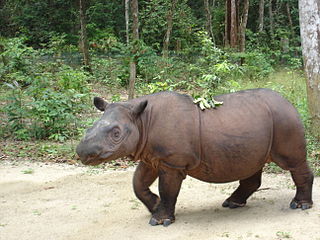
The Sumatran rhinoceros, also known as the Sumatran rhino, hairy rhinoceros or Asian two-horned rhinoceros, is a rare member of the family Rhinocerotidae and one of five extant species of rhinoceros. It is the only extant species of the genus Dicerorhinus. It is the smallest rhinoceros, although it is still a large mammal; it stands 112–145 cm (44–57 in) high at the shoulder, with a head-and-body length of 2.36–3.18 m and a tail of 35–70 cm (14–28 in). The weight is reported to range from 500–1,000 kg (1,100–2,200 lb), averaging 700–800 kg (1,500–1,800 lb), although there is a single record of a 2,000 kg (4,400 lb) specimen. Like both African species, it has two horns; the larger is the nasal horn, typically 15–25 cm (5.9–9.8 in), while the other horn is typically a stub. A coat of reddish-brown hair covers most of the Sumatran rhino's body.
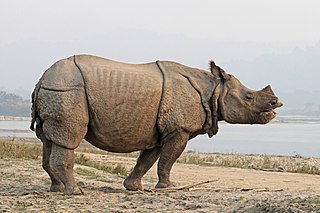
The Indian rhinoceros, also called the Indian rhino, greater one-horned rhinoceros or great Indian rhinoceros, is a rhinoceros species native to the Indian subcontinent. It is listed as Vulnerable on the IUCN Red List, as populations are fragmented and restricted to less than 20,000 km2 (7,700 sq mi). Moreover, the extent and quality of the rhino's most important habitat, the alluvial Terai-Duar savanna and grasslands and riverine forest, is considered to be in decline due to human and livestock encroachment. As of August 2018, the global population was estimated to comprise 3,588 individuals, including 2,939 individuals in India and 649 in Nepal. Kaziranga National Park alone had an estimated population of 2,048 rhinos in 2009. Pobitora Wildlife Sanctuary in Assam has the highest density of Indian rhinos in the world with 84 individuals in an area of 38.80 km2 (14.98 sq mi) in 2009.

Chester Zoo is a zoo at Upton-by-Chester, Cheshire, England. Chester Zoo was opened in 1931 by George Mottershead and his family. It is one of the UK's largest zoos at 51 hectares. The zoo has a total land holding of approximately 160 hectares.
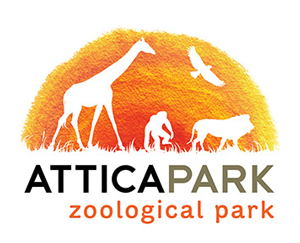
Attica Park, officially Attica Zoological Park (AZP), is a private zoo located in the suburb of Spata, approximately 20 kilometres (12 mi) east of Athens, Greece. It is the only zoo in Greece. The zoo is home to more than 1,500 animals representing 220 species, in an area of 20-hectares. It is open 365 days a year.

Captive breeding, also known as captive propagation, is the process of maintaining plants or animals in controlled environments, such as wildlife reserves, zoos, botanic gardens, and other conservation facilities. It is sometimes employed to help species that are being threatened by the effects of human activities such as climate change, habitat loss, fragmentation, over hunting or fishing, pollution, predation, disease, and parasitism.

The African wild ass or African wild donkey is a wild member of the horse family, Equidae. This species is thought to be the ancestor of the domestic donkey, which is sometimes placed within the same species. They live in the deserts and other arid areas of the Horn of Africa, in Eritrea, Ethiopia and Somalia. It formerly had a wider range north and west into Sudan, Egypt, and Libya. It is Critically Endangered, with about 570 individuals existing in the wild.

The Somali wild ass is a subspecies of the African wild ass.

La Palmyre Zoo is a zoo in Les Mathes, Charente-Maritime, near Royan, in southwestern France. It was created in 1966 in the forest of la Coubre by Claude Caillé. Extending over 18 hectares, including 14 of landscape garden, it offers the visitor the opportunity of observing more than 1600 animals of all kinds, divided into 145 species, over a distance of more than 4 kilometres (2.5 mi).
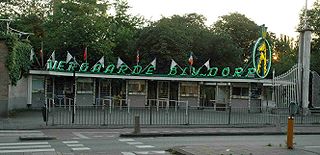
Diergaarde Blijdorp, officially Rotterdam Zoo, is a zoo located in the northwestern part of Rotterdam. It is one of the oldest zoos in the Netherlands, and has been operated by the Stichting Koninklijke Rotterdamse Diergaarde. Divided into several zoogeographic regions, the 26-hectare (64.25-acre) Blijdorp Zoo boasts well over 180 species. It also has a shop, multiple cafes, and an information centre.

The northern white rhinoceros, or northern square-lipped rhinoceros, is one of two subspecies of the white rhinoceros. Formerly found in several countries in East and Central Africa south of the Sahara, this subspecies is a grazer in grasslands and savanna woodlands. Since 19 March 2018, there are only two known rhinos of this subspecies left, called Najin and Fatu, both of which are female; barring the existence of unknown or misclassified male northern white rhinos elsewhere in Africa, this makes the subspecies functionally extinct. The two female rhinos belong to the Dvůr Králové Zoo in the Czech Republic but live in the Ol Pejeta Conservancy in Kenya and are protected round-the-clock by armed guards.

The American Species Survival Plan or SSP program was developed in 1981 by the (American) Association of Zoos and Aquariums to help ensure the survival of selected species in zoos and aquariums, most of which are threatened or endangered in the wild.

The San Antonio Zoo is an Association of Zoos and Aquariums-accredited zoo in Midtown San Antonio, Texas, United States. It is located in the city's Brackenridge Park. San Antonio Zoo is a 50+ acre zoo home to over 750 species, some of which are endangered or extinct in the wild, and an annual attendance of more than 1 million. It also runs non-animal attractions, such as the 2 ft narrow gauge San Antonio Zoo Eagle train ride, which first opened in 1956 and utilizes three Chance Rides C.P. Huntington locomotives.
The EAZA Ex-situ Programme (EEP), formerly known as European Endangered Species Programme, is a population management programme for animals of the European Association of Zoos and Aquaria (EAZA). It is one of the worldwide assembly of such regional breeding programs for threatened species in zoos. The North America counterpart is the Species Survival Plan (SSP); Australian, Japanese, Indian, and Chinese zoos also have similar programs. Combined, there are now many hundred zoos worldwide involved in regional breeding programs. Each EEP has a coordinator who is assisted by a species committee. The coordinator collects information on the status of all the animals kept in EAZA zoos and aquariums of the species for which he or she is responsible, produces a studbook, carries out demographic and genetic analyses, produces a plan for the future management of the species and provides recommendations to participating institutions. Together with the Species Committee, recommendations are made each year about relocating and breeding animals, and the conditions of such a move.

The ZooParc de Beauval, more commonly called Beauval Zoo or, more simply, Beauval, is a French zoological park located in Saint-Aignan-sur-Cher, Centre-Val de Loire. It features more than 35,000 animals on 40 hectares, which is one of the largest animal collections in France and in Europe. Created in 1980 by Françoise Delord, it is now run by her son, Rodolphe Delord, and managed by his family, which owns most of the capital.

Zoo Basel is a non-profit zoo in the city of Basel, Switzerland. Its official name is Zoologischer Garten Basel — or in English: Basel Zoological Garden. Basel residents affectionately call it Zolli. Its main entrance is just outside Basel's downtown strip of Steinen-Vorstadt and extends in the Birsig stream valley to Basel's city border with Binningen, Basel-Country.

Zodiac Zoos is a Dutch corporation that owns and operates Aqua Zoo Friesland, Zoo Wissel, Zoo Labyrinth Boekelo, Zoo Park Overloon, and Castle Arcen.
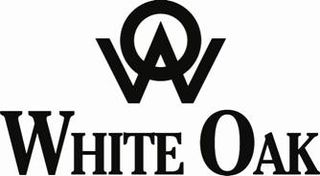
White Oak Conservation, which is part of Walter Conservation, is a 17,000-acre (6,900 ha) conservation center in northeastern Florida. It has long been dedicated to the conservation and care of endangered and threatened species, including rhinoceros, okapi, bongo antelope, zebras, dama gazelles, and cheetahs.

The Northeast African cheetah is a cheetah subspecies occurring in Northeast Africa. Contemporary records are known in South Sudan and Ethiopia, but population status in Eritrea, Djibouti, Somalia and Sudan is unknown.
